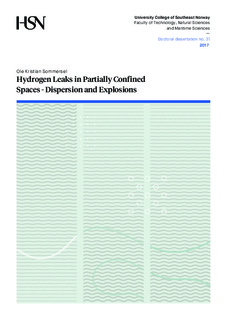Hydrogen leaks in partially confined spaces - dispersion and explosions
Doctoral thesis
Published version
Permanent lenke
http://hdl.handle.net/11250/2468618Utgivelsesdato
2017-12-12Metadata
Vis full innførselSamlinger
Sammendrag
In Porsgrunn, Norway, there was an explosion in an ammonia plant in July 1985. The accident was caused by a hydrogen leak inside a factory building, called N1. The result was a severe hydrogen-air explosion and jet fire, which led to massive material damages and two fatalities. The 100 meter long building where the explosion occurred was completely destructed.
The basis for this thesis is the accident in the N1 ammonia plant hydrogen, where one of the main goals was to re-investigate the chain of events. The N1 factory building has been the model for both small-scale and field-scale experimental campaigns. The objective of the thesis is to get a better understanding of the dispersion of hydrogen and inhomogeneous hydrogen explosions in long buildings, channels and tunnels.
A laboratory scale experimental rig was built for studying dispersion and ignition of hydrogen gas clouds in an open channel. The rig was designed to study the gas cloud frontal velocity and the generated overpressure in the combustion of the hydrogen released. The experimental campaign was studied numerically, by use of the commercial CFD code FLACS.
A field-scale experimental rig was set up in Raufoss to study dispersion and ignition of inhomogeneous hydrogen gas clouds at a larger scale. The experimental campaign was designed to study the effects on generated explosion overpressures by varying mass flow rate, jet direction, time of ignition and level of obstructions. Subsequently, the experiments were studied numerically in FLACS.
Finally, FLACS was used to re-investigate the N1 accident through five different inhomogeneous hydrogen gas cloud scenarios. The scenarios were varied with respect to basic geometry and jet direction.

